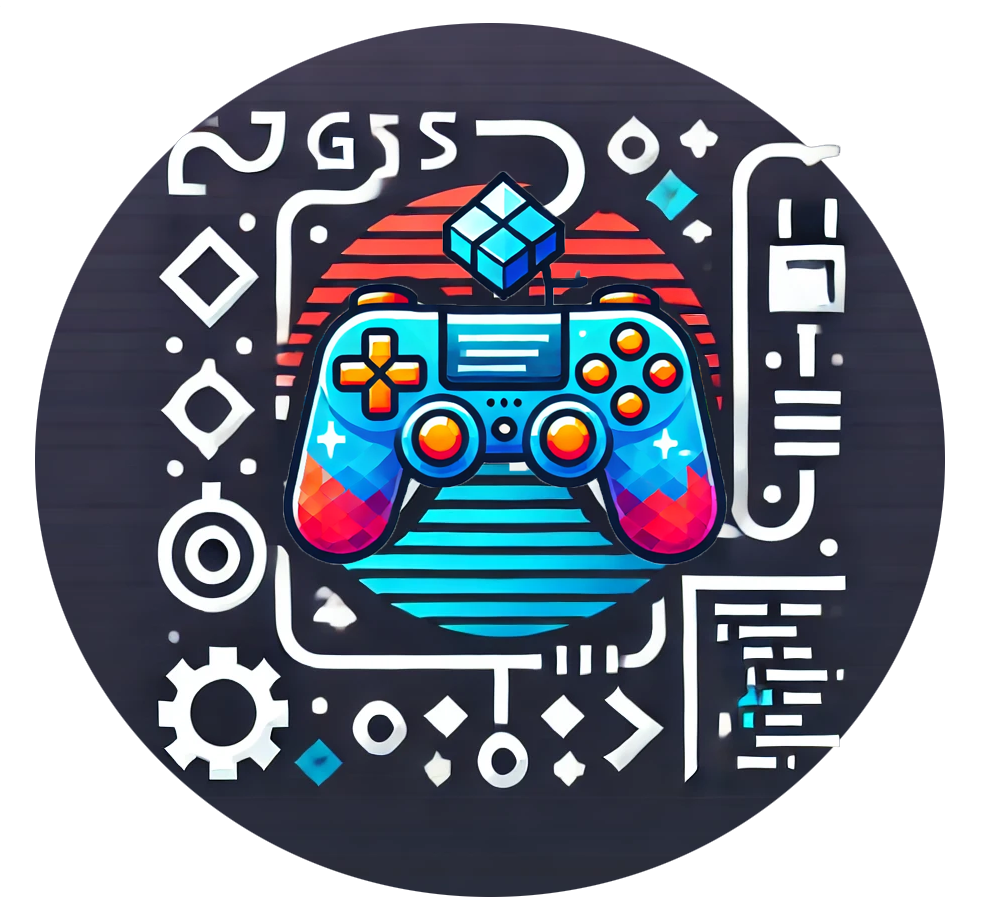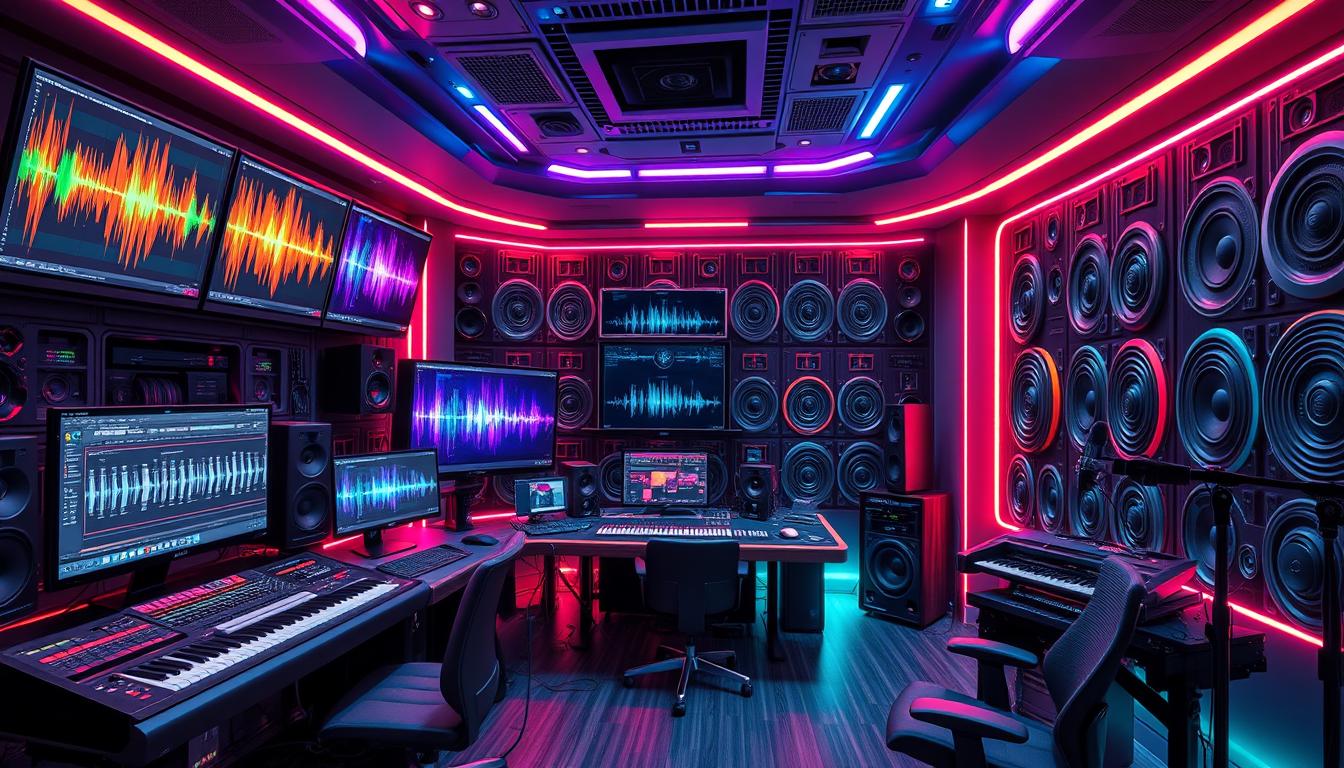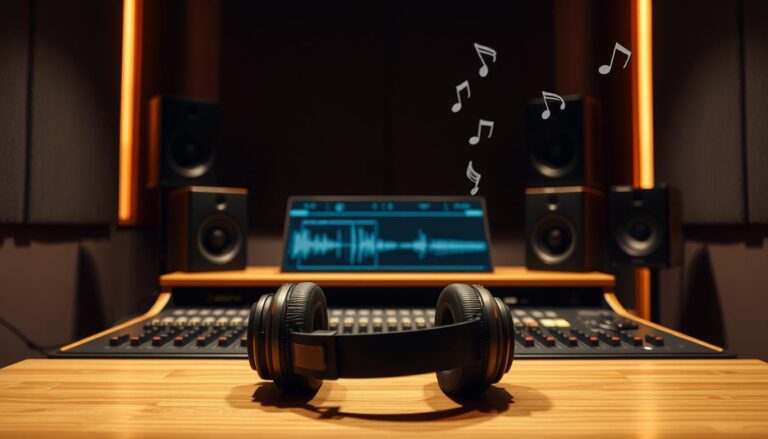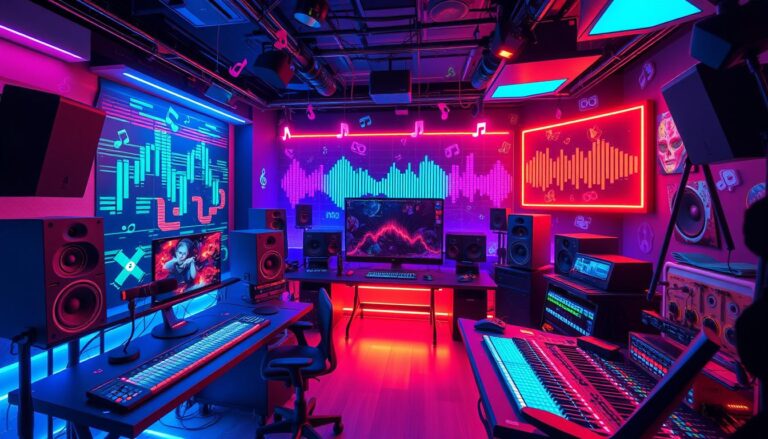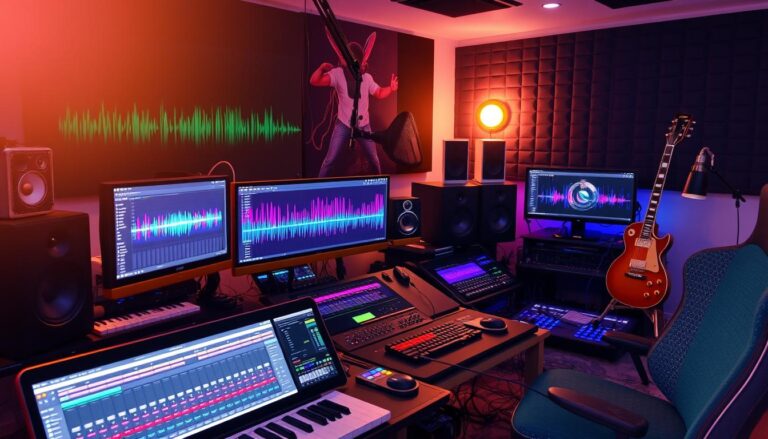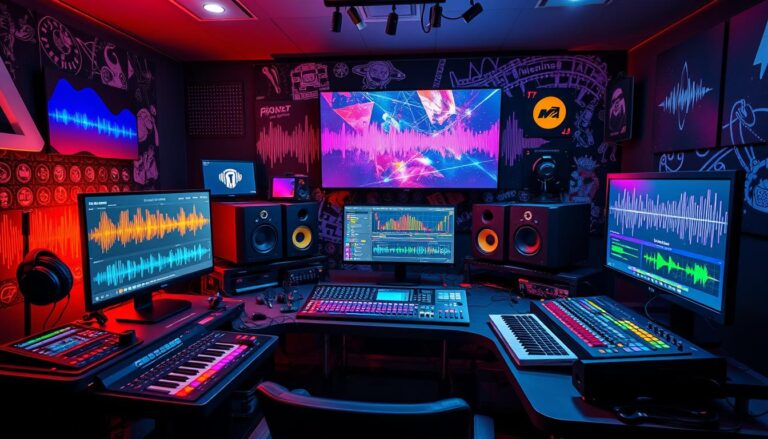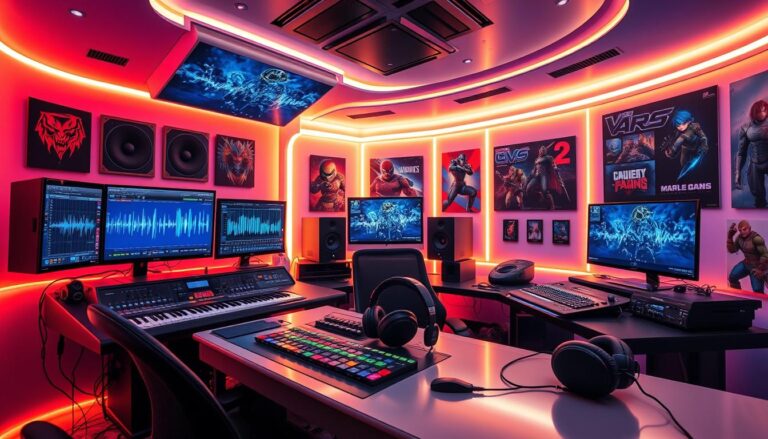What Are Common Mistakes in Game Sound Design?
Creating immersive gaming experiences needs careful attention to sound design and audio effects. Even experienced sound designers make common mistakes. These can hurt the player’s experience.
Ignoring the client’s brief and overusing sound effects are big mistakes. They can lessen the audio’s impact and mess up the game’s flow.
One big issue is focusing too much on single sound elements. Sound designers should think about the audio’s role in the game. They also need to balance creativity with technical skills.
Striking the right balance is key. Some designers get too caught up in literal thinking. They miss out on new sound design ideas.
Another mistake is using too many sound effects. This can make the scene’s purpose unclear. It’s also bad to fill every space with sound, forgetting the power of silence.
Good audio file management and optimization are crucial. Poor recording quality or bad resource use can harm the game’s performance and user experience.
Understanding the Fundamentals of Game Sound Design and Audio Effects
Making the perfect sound for a game is a mix of creativity and technical skills. At its heart, game sound design has key elements that work together. They aim to pull players into the game and make their experience better.
Core Elements of Audio Design
The base of game audio design includes four main parts: music, dialogue, sound effects, and ambient noise. Each part is vital in creating the game’s sound world. They help shape the atmosphere and give feedback to the player.
The Role of Sound in Player Experience
Sound design is key in making a game engaging. It offers feedback, sets the mood, and boosts immersion. The right sounds can guide the player, confirm their actions, and stir emotions.
Balance Between Creative and Technical Aspects
Creating great game sound design needs a mix of creativity and tech. Sound designers use tools like FMOD, Wwise, or Fabric to manage sound well. They also follow sound design rules to bring their vision to life and engage the player.
Knowing the basics of game sound design and audio effects helps sound designers create a rich, engaging sound experience. This sound experience should match the game’s visuals and story, making the game more enjoyable for the player.

| Technique | Description | Example |
|---|---|---|
| Layering Sounds | Combining multiple sound elements to create depth and complexity in the mix. | Layering a foley recording of footsteps with an audio middleware-generated environmental ambiance and a subtle voice acting overlay to simulate a realistic outdoor setting. |
| Filtering and EQ | Using various filters and equalization techniques to shape the frequency content of sounds. | Applying a low-pass filter to a sound effect to create a muffled, distant quality, and boosting specific frequencies to enhance the impact of a foley recording of a door slam. |
| Modulation and Effects | Utilizing modulation sources and audio effects to add movement, texture, and character to sounds. | Applying a subtle vibrato effect to a voice acting recording to convey a sense of nervousness, or using a pitch-shifting effect to create a unique, otherworldly audio middleware-generated sound. |
Technical Oversights in Audio Implementation
In game sound design, technical mistakes can greatly affect the player’s experience. Sound designers face many challenges, from optimizing audio files to ensuring smooth playback on different devices.
One big mistake is not using audio middleware like Wwise or FMOD. These tools help manage sound files and add dynamic audio processing. They make sure the sound fits perfectly with the game’s actions and events.
- Not optimizing audio files can slow down games and upset players. Sound designers need to pick the right file formats and settings. This ensures the audio quality is good without taking up too much space.
- Testing audio on various devices is key. This includes phones, tablets, consoles, PCs, TVs, and different speakers and headphones. It’s important to make sure the audio works well everywhere for a great player experience.
| Tool | Description | Price |
|---|---|---|
| Reaper DAW | Powerful and versatile digital audio workstation | $60 (personal), $225 (commercial) |
| Melda Plugins | Suite of 37 free high-quality sound design plugins | Free |
| Soundtoys Effect Rack | Award-winning collection of audio processing tools | Normally $299, often on sale for around $130 |
By fixing these technical issues and using the right tools, sound designers can make sure the sound synthesis and procedural audio in games work well. This focus on technical details is vital for creating an immersive audio experience that matches the game’s visuals and story.
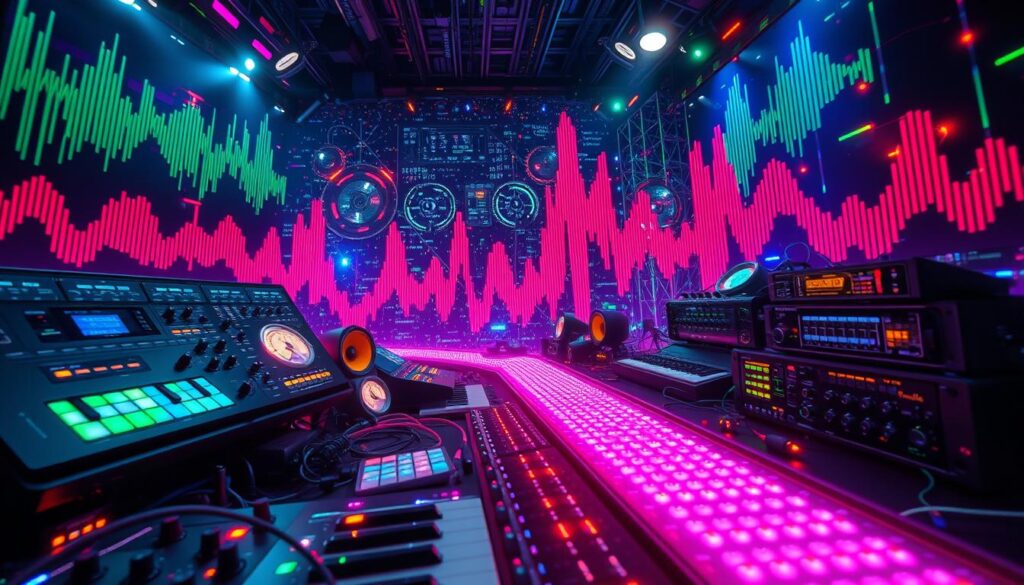
Poor Audio File Management and Optimization
Managing and optimizing audio files is key for great game audio. Not doing this can cause big problems. These include slow loading times, memory issues, and poor audio quality for players.
File Format and Compression Issues
Sound designers need to pick the right file formats and use smart compression. This keeps file sizes small without losing audio quality. Using big, uncompressed files can slow down games.
By using game music composition and ambisonic mixing, developers can balance file size and sound quality well.
Resource Management Problems
Good resource management is vital for smooth game audio. This means cutting out unnecessary silence, using dynamic range compression, and managing sound assets well. It helps avoid problems like voice starvation and CPU spikes.
Storage and Performance Considerations
Thinking about storage and performance is crucial for game audio. Tools like Audacity, FFMPEG, or Sound Forge help sound designers optimize audio files. They make sure audio uses memory and processing power wisely.
This includes watching CPU use, voice count, and other important metrics. It helps spot and fix any performance issues.
| Metric | Gen 8 | Gen 9 | PC |
|---|---|---|---|
| Total Media Memory Budget for Audio | 250MB | 250MB | 250MB |
| CPU Peak Values | 100% | 80% | 80% |
| Average CPU Consumption | Below 50% | Below 30% | Below 30% |
Mixing and Leveling Errors
Proper audio mixing and leveling are key for an immersive game soundscape. Mixing mistakes can ruin the game feel, causing distortion, clipping, or hiding important sounds.
Audio designers must balance sound levels carefully. This includes dialogue, sound effects, and music. They use tools like normalization, equalization, and dynamic range compression to place each sound right.
Tools like sound meters and waveform monitors help achieve the right mix. The goal is to make sure important dialogue is clear over the background sounds. This lets players fully enjoy the immersive soundscapes.
| Common Mixing Errors | Solutions |
|---|---|
| Distortion and clipping due to improper gain staging | Employ normalization and dynamic range compression techniques |
| Masking of important audio cues by excessively loud sound effects or music | Use equalization and volume automation to balance levels |
| Dialogue being overpowered by ambient noise or sound effects | Prioritize dialogue through careful mixing and ducking |
| Inconsistent volume levels between different sound elements | Utilize metering tools and calibrate overall mix balance |
Fixing these common mixing and leveling mistakes makes games better. It improves the interactive sound experience, making the game world more engaging and immersive.
Creative and Conceptual Missteps
In the world of game sound design and audio effects, mistakes can really hurt the gaming experience. One big mistake is adding too many sounds or layers. This can make the audio feel messy and hard to follow. Sound designers need to find the right balance, making sure each sound adds to the game.
It’s also key to think about the context and environment of the game. Sound designers should really get the game’s style, mood, and theme. If they don’t, the audio might not match the game’s look and story, which can pull players out of the game.
Lack of Dynamic Range
A common mistake is not using enough dynamic range. Audio that’s too even can get boring and make players lose interest. Sound designers should mix up sounds, volumes, and rhythms to keep the game exciting. This makes the game feel more alive and engaging.
Looking at other games with great audio can be really helpful. By studying how they use sound, designers can learn new ways to improve their own work. This can help them make games that are more fun and immersive for players.
| Common Mistakes in Game Sound Design | Potential Impact |
|---|---|
| Overcomplicating Sound Design | Cluttered and disjointed audio landscape, diminishing player immersion |
| Ignoring Context and Environment | Disconnect between audio and visual/narrative elements, reducing overall impact |
| Lack of Dynamic Range | Monotonous audio experience, leading to player disengagement |
Conclusion
Creating engaging gaming experiences needs a deep understanding of sound design and audio effects. Sound designers must avoid common mistakes to improve their work’s quality. They should focus on the basics and pay attention to every detail.
Good game sound design is more than just cool sounds. It’s about making the player feel like they’re part of the game. By blending sound, visuals, and gameplay, designers can make the game world feel real. They must keep learning, testing, and focusing on their goals to excel in game audio.
As technology gets better, sound designers must keep up with new tools and methods. They face challenges like 3D audio in virtual reality and optimizing for mobile games. By staying creative, working together, and being technically skilled, designers can make games that truly connect with players.
